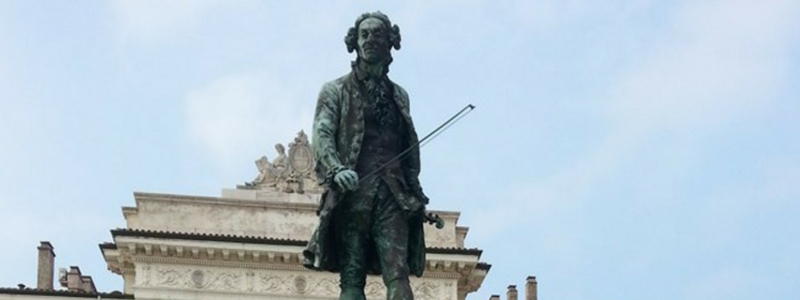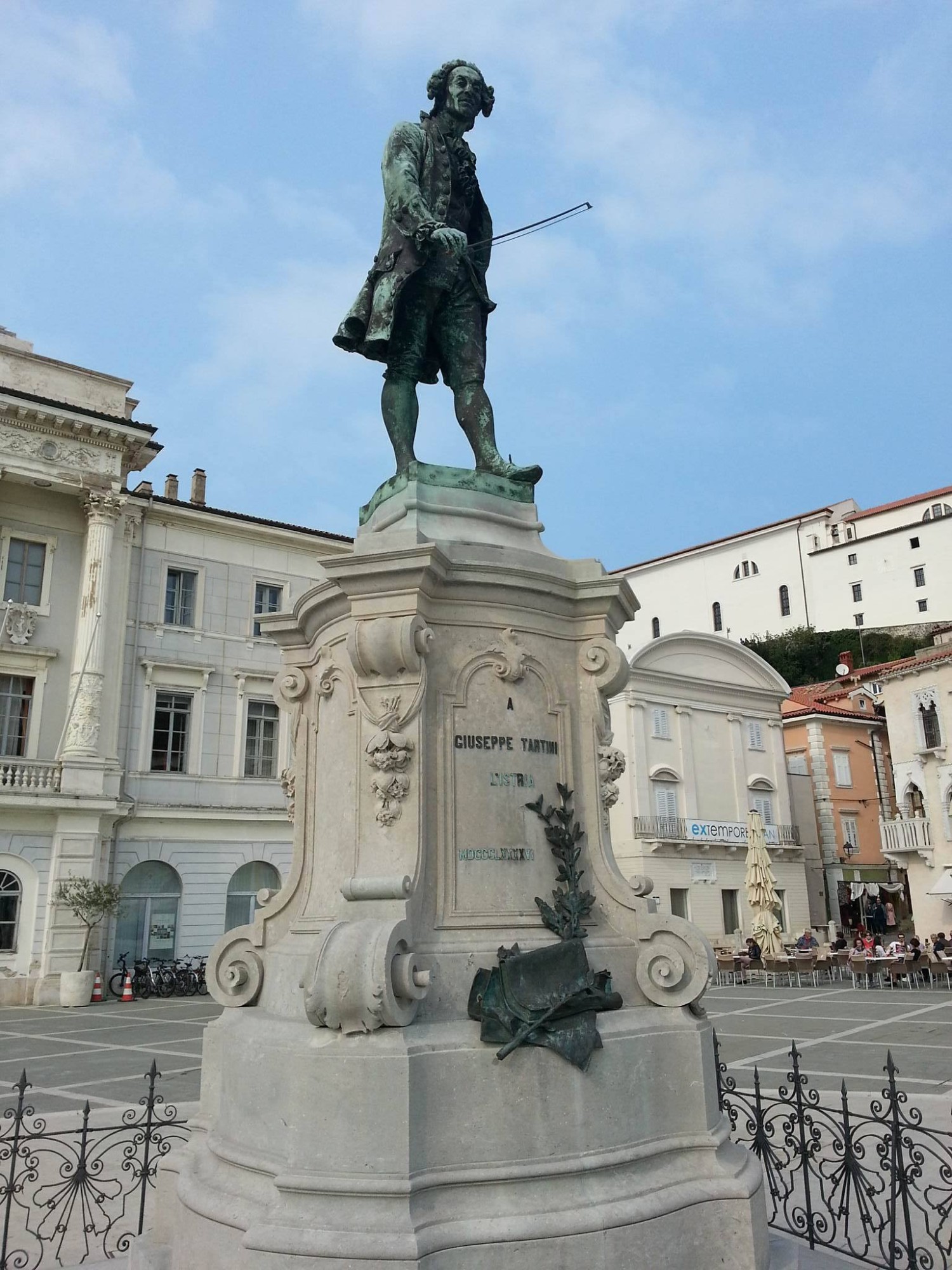Tartini Square, named after Giuseppe Tartini (1692–1770), Piran’s most famous native, lies in the heart of this compactly built coastal medieval town. The square was once an inner harbour for smaller vessels, a mandrač, which was filled in 1894.
The idea to erect a monument dedicated to the violin virtuoso and composer emerged in 1888, when a committee organising a ceremony to commemorate the bicentennial of Giuseppe Tartini’s birth was established, consisting of eminent citizens of Piran. Subsequently, representatives of nineteen Istrian cities involved in organising this large-scale pan-Istrian cultural manifestation were appointed to the committee. Despite receiving broad support, the monument’s construction was impeded due to delays in filling in the harbour and other complications, and the memorial was not unveiled until four years later, on 2 August 1896. Not merely a local commemoration, the whole of Istria joined in the celebrations, and over 4600 people arrived by sea to attend the inaugural ceremony. The festivities, taking place throughout the whole day and culminating in night-time fireworks, were documented by photographers Alfredo Pettener, B. Circovich, Emilio Rendich, Lorenzo Novak and others.
Based on designs by renowned artists, the monument was erected in a well-considered spot: at the intersection of the Town Hall perpendicular and the Church of St George’s bell tower axis. Sculptor Dal Zotto, who arrived in Piran with the sole aim of attending to this matter in March 1894, had the final say in determining the statue’s location.
The super-sized bronze statue of the violinist and composer was made by an illustrious Venetian sculptor, Antonio Dal Zotto (1841–1918), who had already created a number of public monuments. The grey stone pedestal was carved by stonecutter Antonio Tamburlini from Trieste. After the unveiling, the monument and its maker received lavish public praise and recognition from professional circles, who proclaimed the statue Zotto’s finest creation.
During the 2016 restoration works, the Restoration Centre of the Institute for the Protection of Cultural Heritage of Slovenia (ZVKDS) discovered a dedication to Zotto’s wife, Ida Lessiak Naya, who passed away during the preliminary sculpting process. Inconspicuously inscribed on the violin and thus remaining concealed for as long as one hundred and twenty years, the dedication reads: “Ida Lessiach Naya Dal Zotto Buona Sapiente Bella Volò a Dio 9-19-1893 Il Suo Anton Dal Zotto.” In English translation: Ida Lessiach Naya Dal Zotto, good, wise, beautiful, taken by God on 9/19/1893, her Anton dal Zotto.
Duška Žitko
Giuseppe Tartini
Piran-born violin virtuoso and music theorist Giuseppe Tartini (1692–1770) was a composer of late baroque and early classicism. Working most of his life in the Republic of Venice, mainly in Padua, his legacy – particularly the family documents and theoretical writings kept in his birthplace – bears testimony to the composer’s early period in his native town.
Tartini’s father, Giovanni Antonio, was the director of the Piran saltpans and intended his son to become a friar. To this end, Tartini received a musical training in Piran and was later enrolled in the Collegio dei padri delle scuole Pie in Koper/Capodistria, where he also took instruction in humanities and rhetoric. He left his native town in 1708 never to return, although the land and the specific features of its music folklore purportedly – according to references found in some of his writings – made a lasting impression on him. Tartini studied law at Padua, and at the same time established a reputation as a fencer.
After his father’s death in 1710, he married Elisabetta Premazore, a woman who would have incurred his father’s disapproval, because of her lower social class and age difference. In marrying Elisabetta, Tartini offended the sentiments of the powerful Cardinal Giorgio Cornaro, and consequently took refuge at Assisi. In the St Francis Monastery, Tartini enjoyed the protection of Father Torre, a kinsman from Piran, and after his death, supported himself as a musician. We learn from his Trattato di musica (Treatise on Music) that he was in the orchestra of the Ancona Opera in 1714. He claimed that it had been then that he discovered the acoustic phenomenon of terzo suono, or the combination tone. The discovery was to play an essential role in his theories and influenced his composing and violin technique. While Tartini’s relatively idiosyncratic mathematical ideas made only a marginal impact at the time, his findings in physics later laid a foundation for contemporary acoustics.
Tartini held concerts at Parma (1728), Bologna (1730), Camerino (1735), Ferrara (1739) and, particularly, Venice. He established a violin school in Padua, which attracted students from all over Europe, and Tartini was dubbed ‘a maestro (teacher) of nations’. His school focused intensively on establishing a modern style of violin bowing, introducing techniques that enabled the performance of Tartini’s innovative music style. Besides violin playing, Tartini taught composition.
The first notable owner of a Stradivarius violin, Tartini later presented it to one of his talented students, Mazzurani, who gave it to a Polish composer and violinist, Karol Lipiński (the instrument is today known as the Lipinski Stradivarius).
Tartini’s extensive music creativity is marked by two instrumental genres, solo works for violin (concerti) and violin sonatas. His instrumental output, amounting to approximately 130 concerti and over 180 chamber works, is complemented by an oeuvre of around 20 religious vocal pieces. Tartini’s style reflects the marked influence of Arcangelo Corelli.
The genesis of Tartini’s foremost violin sonata in G minor, Trillo del Diavolo (Devil’s Trill), is surrounded by an aura of mysticism. Tartini wrote the piece after waking from a particularly vivid dream of the Devil – with whom he had made a pact for his soul – playing a violin with breath-taking virtuosity.
Maia Juvanc



